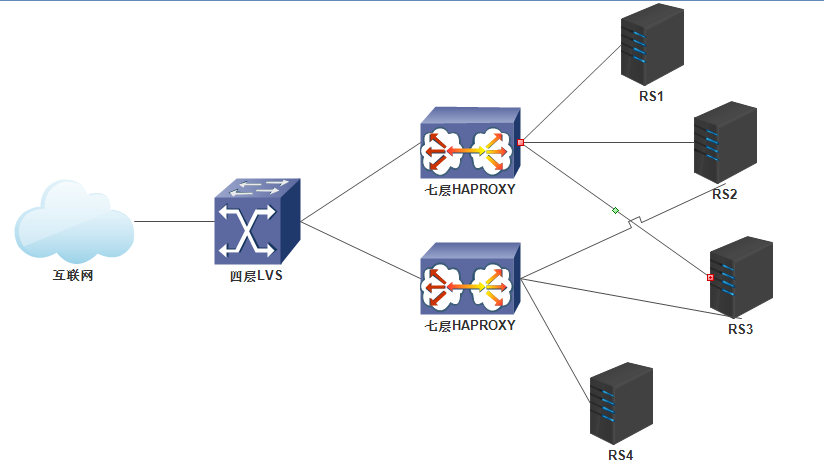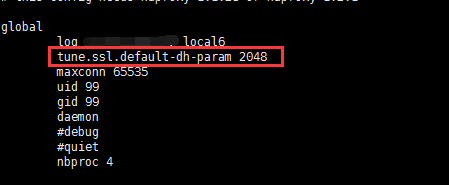前沿
据悉苹果强制APP在2016年底使用ATS协议,所以公司准备将部分站点http统一替换成https。所有我们就得测试下
1.首先原有的haproxy1.5升级到了1.7版本支持ssl
2.查看相关文档,测试
3.如果站点经过CDN加速,还需要确认CDN是否支持https或者支持是否收取额外费用
4.等等。。。。。。
1.现有环境

2.haproxy代理ssl模式
haproxy 代理 ssl 有两种方式
1、haproxy 本身提供ssl 证书,后面的web 服务器走正常的http (偷懒方式)
2、haproxy 本身只提供代理,后面的web服务器https

-
第一种是我们选择的模式,在haproxy这里设定SSL,这样我们可以继续使用七层负载均衡。SSL连接终止在负载均衡器haproxy ----->解码SSL连接并发送非加密连接到后端应用tomcat,这意味着负载均衡器负责解码SSL连接,这与SSL穿透相反,它是直接向代理服务器发送SSL连接的。
-
第二种使用SSL穿透,SSL连接在每个tomcat服务器终止,将CPU负载都分散到tomcat服务器。然而,这样做会让你失去增加或修改HTTP报头的能力,因为连接只是简单地从负载均衡器路由到tomcat服务器,这意味着应用服务器会失去获取 X-Forwarded-* 报头的能力,这个报头包含了客户端IP地址、端口和使用的协议。
-
有两种策略的组合做法,那就是第三种,SSL连接在负载均衡器处终止,按需求调整,然后作为新的SSL连接代理到后台服务器。这可能会提供最大的安全性和发送客户端信息的能力。这样做的代价是更多的CPU能耗和稍复杂一点的配置。
-
选择哪个策略取决于你及应用的需求。SSL终端为我所见过最典型的策略,但SSL穿透可能会更安全。
ps:这段是招扒的wangzan18的。在此谢谢
第一种方式
需要编译haproxy 支持ssl,编译参数:
make TARGET=linux26 USE_OPENSSL=1 ADDLIB=-lz ldd haproxy | grep ssl libssl.so.10 => /usr/lib64/libssl.so.10 (0x00007fb0485e5000)
配置参数:
frontend https_frontend bind *:443 ssl crt /etc/ssl/certs/servername.pem mode http option httpclose option forwardfor reqadd X-Forwarded-Proto: https default_backend web_server backend web_server mode http balance roundrobin cookie SERVERID insert indirect nocache server s1 192.168.250.47:80 check cookie s1 server s2 192.168.250.49:80 check cookie s2
注意:这里的pem 文件是下面两个文件合并而成:
cat servername.crt servername.key |tee servername.pem
第二种方式配置
不需要重新编译支持ssl,简单方便。需要后面的web服务器配置好ssl 即可。
frontend https_frontend
bind *:443
mode tcp
default_backend web_server
backend web_server
mode tcp
balance roundrobin
stick-table type ip size 200k expire 30m
stick on src
server s1 192.168.250.47:443
server s2 192.168.250.49:443
注意:这种模式下mode 必须是tcp 模式
3.配置说明
这一行要加,要不然reload会警告
tune.ssl.default-dh-param 2048

保留80,同时支持443 ssl,后面指定证书文件

redirect scheme https if !{ ssl_fc }
这一行是仅支持ssl,效果是:访问80端口是自动跳转到443的ssl
这是针对node生效,如果想全局使用的话,可以把这句话添加到frontend下

这是针对node生效,如果想全局使用的话,可以把这句话添加到frontend下

===================================================================================================================
HAProxy同时对80和443做负载均衡:
注:
1、该操作依据Redhat/CentOS 6系统
2、https使用mode tcp(不需要配置crt,使用实际web的crt)
3、需注掉option httplog和option forwardfor except 127.0.0.0/8
vi /etc/haproxy/haproxy.cfg
option httplog
option forwardfor except 127.0.0.0/8
frontend main *:80
stats uri /haproxy?stats
default_backend http
backend http
balance roundrobin
server 10.0.0.3 10.0.0.3:80 check
server 10.0.0.4 10.0.0.4:80 check
frontend main *:443
mode tcp
default_backend httpsbackend https
mode tcp
balance roundrobin
server 10.0.0.3 10.0.0.3:443 check
server 10.0.0.4 10.0.0.4:443 check
:wq
service haproxy restart
验证:
浏览器访问:http://xxxx (推荐域名访问),https://xxxxx
haproxy状态页面:http://xxxx/haproxy?stats (可以看http和https分配情况)
=======================================================================================
global
# to have these messages end up in /var/log/haproxy.log you will
# need to:
#
# 1) configure syslog to accept network log events. This is done
# by adding the '-r' option to the SYSLOGD_OPTIONS in
# /etc/sysconfig/syslog
#
# 2) configure local2 events to go to the /var/log/haproxy.log
# file. A line like the following can be added to
# /etc/sysconfig/syslog
#
# local2.* /var/log/haproxy.log
#
log 127.0.0.1 local2
chroot /var/lib/haproxy
pidfile /var/run/haproxy.pid
maxconn 4000
user haproxy
group haproxy
daemon
# turn on stats unix socket
stats socket /var/lib/haproxy/stats
#---------------------------------------------------------------------
# common defaults that all the 'listen' and 'backend' sections will
# use if not designated in their block
#---------------------------------------------------------------------
defaults
mode http
log global
option httplog
option dontlognull
option http-server-close
#option forwardfor except 127.0.0.0/8
option redispatch
retries 3
timeout http-request 10s
timeout queue 1m
timeout connect 10s
timeout client 1m
timeout server 1m
timeout http-keep-alive 10s
timeout check 10s
maxconn 3000
#---------------------------------------------------------------------
# main frontend which proxys to the backends
#---------------------------------------------------------------------
#frontend main *:8100
# acl url_static path_beg -i /static /images /javascript /stylesheets
# acl url_static path_end -i .jpg .gif .png .css .js
#
# use_backend static if url_static
# default_backend app
#---------------------------------------------------------------------
# static backend for serving up images, stylesheets and such
#---------------------------------------------------------------------
#backend static
# balance roundrobin
# server static 127.0.0.1:4331 check
#---------------------------------------------------------------------
# round robin balancing between the various backends
#---------------------------------------------------------------------
#ibackend web
# balance roundrobin
# server web01 10.88.8.15:80 check
# server web02 10.88.8.53:80 check
#frontend https_frontend
# bind *:80
# mode tcp
# default_backend web_server
#backend web_server
# mode tcp
# balance roundrobin
# stick-table type ip size 200k expire 30m
# stick on src
# server web01 10.88.8.15:80
# server web02 10.88.8.53:80
listen private_monitoring
bind 0.0.0.0:8100
mode http
option httplog
stats refresh 10s
stats uri /stats
stats realm Haproxy
stats auth admin:admin
listen web_http
bind 0.0.0.0:80
mode tcp
option tcplog
balance roundrobin
timeout client 3h
timeout server 3h
server web1 10.88.8.15:80 check inter 5000 rise 2 fall 3
server web2 10.88.8.53:80 check inter 5000 rise 2 fall 3
listen web_https
bind 0.0.0.0:443
mode tcp
option tcplog
balance roundrobin
timeout client 3h
timeout server 3h
server web01 10.88.8.15:443 check inter 5000 rise 2 fall 3
server web02 10.88.8.53:443 check inter 5000 rise 2 fall 3
